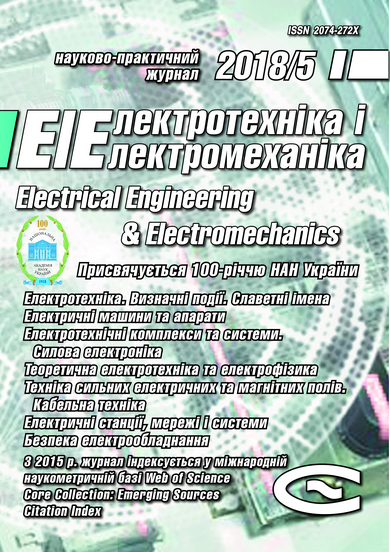PLANNING OF ENERGY CARRIERS BASED ON FINAL ENERGY CONSUMPTION USING DYNAMIC PROGRAMMING AND PARTICLE SWARM OPTIMIZATION
DOI:
https://doi.org/10.20998/2074-272X.2018.5.10Keywords:
particle swarm optimization, final energy consumption, energy planning, energy carriers, dynamic programingAbstract
Purpose. In the present article, a new approach of the energy grid studies is introduced to program energy carriers. In this view, a proper plan is designed on the use of energy carriers considering the energy optimum use. Indeed, the proper energy grid is designed by applying Iran energy balance sheet information. It is proper to mention that, the energy grid modelling is done in a matrix form. The electrical energy distribution among power stations is achieved by using the particle swarm optimization algorithm. In the present paper, concerning the dynamic programming method, it is tried to determine a suitable combination of energy carriers.References
1. Krause T., Andersson G., Fröhlich K., Vaccaro A. Multiple-Energy Carriers: Modeling of Production, Delivery, and Consumption. Proceedings of the IEEE, 2011, vol.99, no.1, pp. 15-27. doi: 10.1109/jproc.2010.2083610.
2. Cormio C., Dicorato M., Minoia A., Trovato M. A regional energy planning methodology including renewable energy sources and environmental constraints. Renewable and Sustainable Energy Reviews, 2003, vol.7, no.2, pp. 99-130. doi: 10.1016/s1364-0321(03)00004-2.
3. Barbir F. Transition to renewable energy systems with hydrogen as an energy carrier. Energy, 2009, vol.34, no.3, pp. 308-312. doi: 10.1016/j.energy.2008.07.007.
4. Amoo L.M., Fagbenle R.L. An integrated impact assessment of hydrogen as a future energy carrier in Nigeria's transportation, energy and power sectors. International Journal of Hydrogen Energy, 2014, vol.39, no.24, pp. 12409-12433. doi: 10.1016/j.ijhydene.2014.06.022.
5. Ridjan I., Mathiesen B.V., Connolly D., Duić N. The feasibility of synthetic fuels in renewable energy systems. Energy, 2013, vol.57, pp. 76-84. doi: 10.1016/j.energy.2013.01.046.
6. Su W., Wang J., Roh J. Stochastic Energy Scheduling in Microgrids With Intermittent Renewable Energy Resources. IEEE Transactions on Smart Grid, 2014, vol.5, no.4, pp. 1876-1883. doi: 10.1109/tsg.2013.2280645.
7. Geng W., Ming Z., Lilin P., Ximei L., Bo L., Jinhui D. China׳s new energy development: Status, constraints and reforms. Renewable and Sustainable Energy Reviews, 2016, vol.53, pp. 885-896. doi: 10.1016/j.rser.2015.09.054.
8. Trop P., Goricanec D. Comparisons between energy carriers' productions for exploiting renewable energy sources. Energy, 2016, vol.108, pp. 155-161. doi: 10.1016/j.energy.2015.07.033.
9. Belier M. E.A.C.a.K.C.H. Interfuel substitution study-the role of electrification. Brookhaven National Laboratory informal Rept. BNL 19522 (ESAG-17), November, 1974.
10. Kennedy J., Eberhart R. Particle swarm optimization. Proceeding of the 1995 IEEE International Conference on Neural Networks,Perth,Australia.IEEEServiceCenter,Piscataway, 1995. pp. 1942-1948.
11. Available at: http://www.saba.org.ir/saba_content/media/image/2015/09/7811_orig.pdf (accessed 16 April 2016).
12. Ebrahimi J., Hosseinian S.H., Gharehpetian G.B. Unit Commitment Problem Solution Using Shuffled Frog Leaping Algorithm. IEEE Transactions on Power Systems,2011, vol.26, no.2, pp. 573-581. doi: 10.1109/tpwrs.2010.2052639.
13. Dehghani M., Montazeri Z., Dehghani A., Seifi A.R. Spring search algorithm: A new meta-heuristic optimization algorithm inspired by Hooke's law. 2017 IEEE 4th International Conference on Knowledge-Based Engineering and Innovation (KBEI). doi: 10.1109/kbei.2017.8324975.
14. Wood A.J., Wollenberg B.F. Power generation, operation, and control. John Wiley & Sons, 2012.
15. IEA Publications, rue dela Fédération, 75739 Paris Cedex 15, Printed in France by STEDI, September 2004.
16. U.S. Energy Information Administration (EIA). Available at: http://www.eia.gov (accessed 21 July 2015).
Downloads
Published
How to Cite
Issue
Section
License
Copyright (c) 2018 M. Dehghani, Z. Montazeri, A. Ehsanifar, A.R. Seifi, M.J. Ebadi, O. M. Grechko

This work is licensed under a Creative Commons Attribution-NonCommercial 4.0 International License.
Authors who publish with this journal agree to the following terms:
1. Authors retain copyright and grant the journal right of first publication with the work simultaneously licensed under a Creative Commons Attribution License that allows others to share the work with an acknowledgement of the work's authorship and initial publication in this journal.
2. Authors are able to enter into separate, additional contractual arrangements for the non-exclusive distribution of the journal's published version of the work (e.g., post it to an institutional repository or publish it in a book), with an acknowledgement of its initial publication in this journal.
3. Authors are permitted and encouraged to post their work online (e.g., in institutional repositories or on their website) prior to and during the submission process, as it can lead to productive exchanges, as well as earlier and greater citation of published work.





